Class Chelonia
Family Testudinidae
Gopherus agassizii—Agassiz's Desert Tortoise // Gopherus morafkai—Morafka's Desert Tortoise // Gopherus/Hesperotestudo—Gopherus or Hesperotestudo Tortoises // Hesperotestudo sp.—Hesperotestudo Tortoises // Hesperotestudo campester—Flat Giant Tortoise // Hesperotestudo wilsoni—Wilson's Tortoise
Members of the family are terrestrial and mostly large. Various giant tortoises of the Pleistocene are referred to this family as are the living species of Gopherus, such as Morafka's Desert Tortoise.
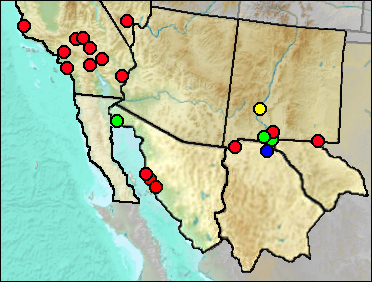
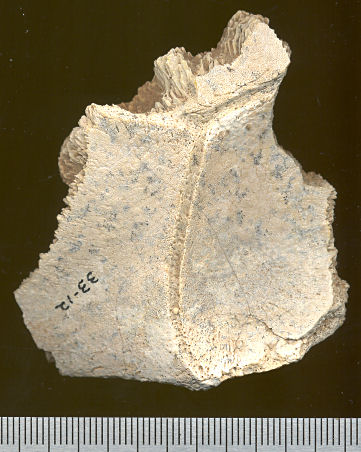 Identification of the Early Irvingtonian specimens are tentative (Vanderhill 1986), but
represent a large tortoise. The Wisconsin specimens likely represent G. morafkai, but those
listed here are insufficient for species identification. The Salt Creek specimen is only
tentatively identified as Gopherus, but the elements appear consistent with those of that
genus.
Identification of the Early Irvingtonian specimens are tentative (Vanderhill 1986), but
represent a large tortoise. The Wisconsin specimens likely represent G. morafkai, but those
listed here are insufficient for species identification. The Salt Creek specimen is only
tentatively identified as Gopherus, but the elements appear consistent with those of that
genus.
Fig. 1. A peripheral element from the carapace of a large tortoise (cf. Gopherus) from the vicinity of La Union, Doña Ana Co., NM. UTEP 33-12. Metric scale.
Fig. 2. Dorsal and ventral views of two elements of a large chelonian from Salt Creek.
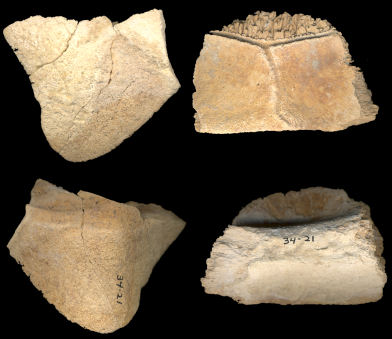
Sites.
Pleistocene: Samalayuca (UTEP).
Late Blancan: Caballo (Morgan et al. 2011).
Early Irvingtonian: El Paso (UTEP: ?); Adobe Ranch (Morgan and Lucas 2005).
Irvingtonian: El Golfo (Croxen et al. 2007: ?).
Late Irvingtonian/Early Rancholabrean: El Evado (Jefferson 1991a).
Rancholabrean: Bitter Springs Playa (Jefferson 1991a); Broadwell Lake West (Jefferson 1991a); Carr Ranch (Jefferson 1991a); Campbell Hill (Jefferson 1991a); Cayucos (Jefferson 2014); Centennial Parkway, Las Vegas Valley (Jefferson et al. 2015); Desemboque del los Seris (White et al. 2010); Desemboque del Río Ignacio (White et al. 2010); Kramer (Jefferson 1991a); Playa San Bartolo A (White et al. 2010); Roswell (Morgan and Harris 2015); Tule Springs (Springer et al. 2005).
Wisconsin: Costeau Pit (Jefferson 1991a).
Mid Wisconsin: U-Bar Cave (UTEP: cf.).
Late Wisconsin: Palo Verde Mesa (Jefferson 2014); Salt Creek (UTEP: cf.); U-Bar Cave 13-14 ka (Harris 1989: cf.); U-Bar Cave 14-15 ka (Harris 1989); U-Bar Cave 18-20 ka (Harris 1989).
Late Wisconsin/Holocene: Conkling Cavern (Brattstrom 1964).
Literature. Croxen et al. 2007; Brattstrom 1964; Harris 1989; Jefferson 1991a, 2014; Jefferson et al. 2015; Morgan and Harris 2015; Morgan and Lucas 2005; Morgan et al. 2011; Springer et al. 2005; Vanderhill 1986.
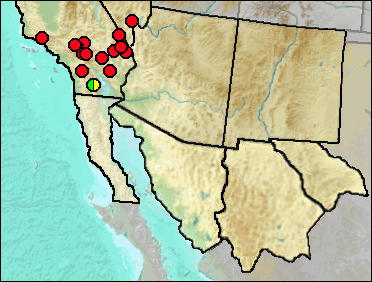
Until relatively recently, the Mojave and Sonoran desert tortoises were considered to belong to this species. Agassiz's Desert Tortoise now is considered to be limited to west of the Colorado River—see the discussion under Gopherus morafkai below.
Sites.
Late Blancan/Irvingtonian: Vallecito Creek, Anza-Borrego Desert (Cassiliano 1999).
Irvingtonian/Rancholabrean: Manix Lake (Jefferson 1991a).
Rancholabrean: Cool Water Coal Gasification site (Jefferson 1991a); Desert Sunlight Project (Jefferson 2014); Ludlow Cave (Jefferson 1991a); Mescal Cave (Jefferson 1991a).
Rancholabrean/?Early Holocene: Mitchell Caverns (Jefferson 1991a: cf.).
Mid Wisconsin: McKittrick (Jefferson 1991a).
Mid/Late Wisconsin: Diamond Valley (Springer et al. 2009).
Late Wisconsin: Antelope Cave (Reynolds, Reynolds, Bell, and Pitzer 1991); Gypsum Cave (Brattstrom 1954).
Late Wisconsin/Holocene: Kokoweef Cave (Reynolds, Reynolds, et al. 1991); Newberry Cave (Jefferson 1991a); Schuiling Cave (Jefferson 1991a); Solar One (Jefferson 1991b).
Literature. Brattstrom 1954; Cassiliano 1999; Jefferson 1991a, Jefferson 2014; Reynolds, Reynolds, et al. 1991; Reynolds, Reynolds, Bell, and Pitzer 1991; Springer et al. 2009.
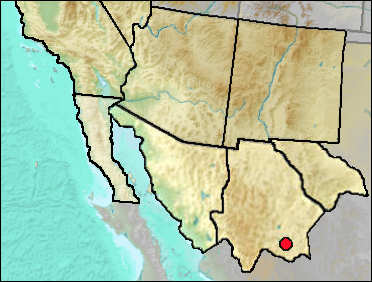
The Bolson Tortoise is the largest of the living species of Gopherus. The historic range approaches the Jimenez Cave area.
Sites.
Mid/Late Wisconsin/Holocene: Jimenez Cave (Messing 1986: cf.).
Literature. Messing 1986.
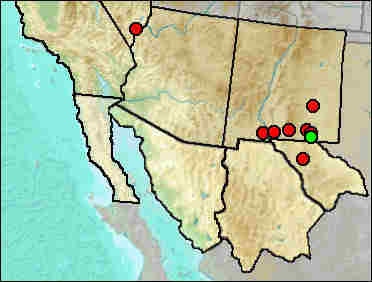
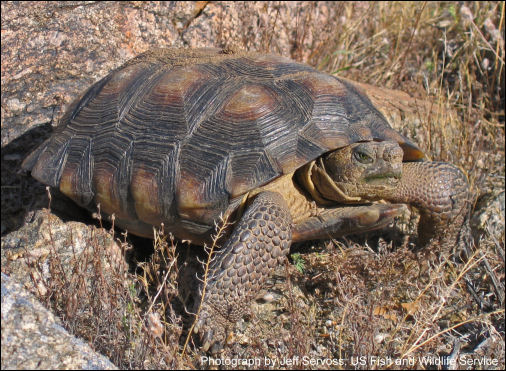
Fig. 1. Morafka's Desert Tortoise. Photograph by Jeff Servoss, courtesy of the U.S. Fish & Wildlife Service.
Synonyms. Gopherus agassizii (part). According to Murphy et al. (2011), Gopherus agassizii occurs only west and north of the Colorado River. The tortoises east and south of the Colorado River, previously also considered to represent G. agassizii, instead represent a separate species, G. morafkai.
It's long been known that the tortoises of the Mojave Desert and those of the Sonoran Desert differ in morphology and behavior. Murphy et al. (2011) clarified nomenclatural problems and named the taxon east and south of the Colorado River as a new species.
Discussion. Today, Morafka's Tortoise is primarily limited to the Sonoran Desert. However, tortoises apparently conspecific to the Sonoran species extended far to the east during at least two times in the Wisconsin and apparently at least once earlier in the Rancholabrean (Pate 2002). Remains from Slaughter Canyon Cave, presumably from the same level as the extinct bat Tadarida constantinei, would be in excess of 209 ± 9 ka (Lundberg and McFarlane 2006; Pate 2002). At Pendejo Cave, remains are found in Zone M, radiocarbon dated at about 35,500 ka, and in Zone C, which includes both terminal Wisconsin and Holocene material. Although the Dry Cave occurrences could also pertain to the ca. 35 ka date, they may be older. The other occurrences east of the present range are terminal Wisconsin with some possibility of Holocene presence. Dates on tortoise epidermal scutes from Shelter Cave (Thompson et al. 1980) range from 12,250 ± 200 (A-1728) to 11,130 ± 500 (A-2141) radiocarbon years B.P.

Brattstrom (1964) noted that many of the bones from Shelter Cave were burned.
In view of its apparent present inability to withstand the periodic hard freezes now typical of even southern New Mexico, Harris (1987) used its presence in conjunction with other taxa to infer mild winters during the times it occurred in the region east of its present range.
Fig. 2. Gopherus morafkai from the Room of the Vanishing Floor, Dry Cave, Eddy County, NM. UTEP 27-88.
The Pleistocene situation in the Lower Grand Canyon region is unclear. Pending clarification, occurrences from the area are considered to pertain to Gopherus morafkai, but the uncertainty should be recognized.
Sites.
Medial Irvingtonian: Slaughter Canyon Cave (Pate 2002).
Pate (2002) listed as G. agassizi. Morgan and Harris (2015) listed as "desert tortoise (Gopherus)".
Early/Early-Mid Wisconsin: Rm Vanishing Floor (Van Devender et al. 1976); Sabertooth Camel Maze (Van Devender et al. 1976).
Mid Wisconsin: Pendejo Cave (Harris 2003); Vulture Cave (Mead 2005: 33,600 ± 1,000 BP to 29,810 ± 1,980 BP).
Mid/Late Wisconsin/Holocene: Sierra Diablo Cave (UTEP); Shelter Cave (Brattstrom 1964).
Late Wisconsin: Muav Gate (Mead 2005: 12,430 ± 270 BP); Rampart Cave (Mead 2005: 16,330 ± 270 BP to 12,230 ± 350 BP); Vulture Canyon (Van Devender et al. 1977a); Vulture Cave No. 8 (Mead 2005: 13,820 ± 220 BP)
Late Wisconsin/Holocene: Conkling Cavern (Brattstrom 1961); Pendejo Cave (Harris 2003); Robledo Cave (Van Devender et al. 1976: cf.)
Literature. Brattstrom 1961, 1964; Harris 1987, 2003; Lundberg and McFarlane 2006; Mead 2005; Morgan and Lucas 2006; Murphey et al. 2011; Pate 2002; Thompson et al. 1980; Van Devender et al. 1976, 1977a.
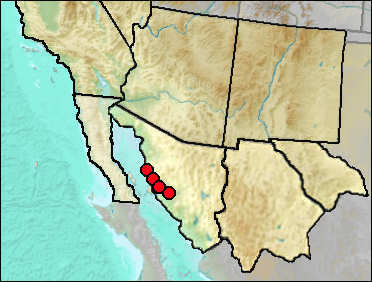
Tortoise remains may be identifiable as tortoise, but not to the generic level. Tortoise remains from La Libertad were given as mostly Gopherus in text but as Gopherus/Hesperotestudo in the table of occurrences (White et al. 2010); they are listed here.
Sites.
Rancholabrean: Hermosillo (White et al. 2010); La Libertad (White et al. 2010); Marlett Locality (White et al. 2010); Playa San Bartolo B (White et al. 2010).
Literature. White et al. 2010.
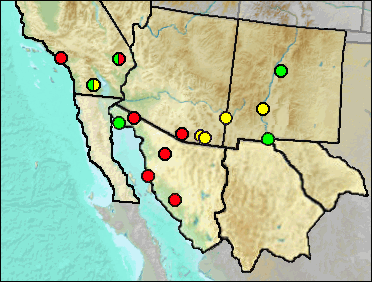
Synonyms. Geochelone, Testudo.
Known as Geochelone in most of the Pleistocene paleontological publications, most of the species were large to very large, with a tendency to decrease in size and retreat to the south geographically through the Pleistocene.
Vanderhill (1986) reported fragmentary material from the Rio Grande Valley-edge deposits in extreme southern New Mexico, tentatively identified to this taxon because of their large size, but the possibility of a large species of Gopherus was noted. A fragmentary specimen (identified as Testudo) from the Gray Sand at Blackwater Loc. No. 1 was thought by Lundelius (1972) to have been redeposited from older beds, and is not included here.
Sites.
Late Blancan: Caballo (Morgan et al. 2011); California Wash (Lindsay 1978); Curtis Ranch (Brattstrom 1955); Virden (Morgan and Lucas 2003).
Late Blancan/Irvingtonian: Vallecito Creek, Anza-Borrego Desert (Cassiliano 1999).
Early Irvingtonian: Adobe Ranch (Morgan and Lucas 2005); Tijeras Arroyo (Morgan and Lucas 2005).
Irvingtonian: El Golfo (Croxen et al. 2007).
Irvingtonian/Rancholabrean: Cadiz (Jefferson 2014).
Rancholabrean: Cerro Colorado (Mead et al. 2005); Desemboque del Río San Ignacio (White et al. 2010); La Playa (White et al. 2010); Melrose Ave. and La Cienega Blvd. (Jefferson 1991a); O'Neil Pass (White et al. 2010); Rancho Aigame (White et al. 2010).
Mid/Late Wisconsin: Rancho La Brea (Jefferson 2014).
Literature. Cassiliano 1999; Croxen et al. 2007; Brattstrom 1955; Jefferson 1991a, Jefferson 2014; Lundelius 1972; Lindsay 1978; Lundelius 1972; Mead et al. 2005; Morgan and Harris 2015; Morgan and Lucas 2003, 2005; Morgan et al. 2011; Vanderhill 1986.
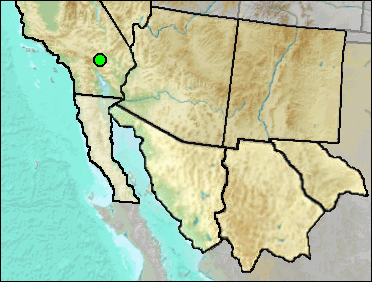
Synonyms. Geochelone campester.
Sites.
Early Irvingtonian: Gypsum Ridge (Wagner and Prothero 2001: cf.).
Literature. Wagner and Prothero 2001.
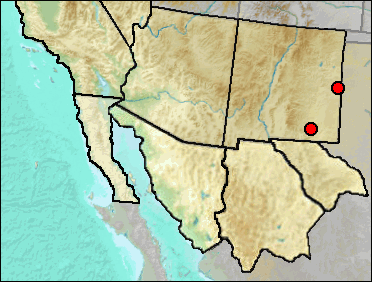
Synonyms. Geochelone wilsoni, Testudo wilsoni.
Wilson's Tortoise is the smallest of a wide variety of Cenozoic species of Hesperotestudo. It appears to be a Wisconsin form distributed from Texas and Oklahoma to eastern New Mexico (Johnson 1987). Dry Cave is the westernmost locality for Wilson's Tortoise and it is associated with the easternmost occurrence of Gopherus morafkai (Van Devender et al. 1976). At Lubbock Lake, TX, and at Blackwater Draw, it apparently survived until Clovis times (Moodie and Van Devender 1979).
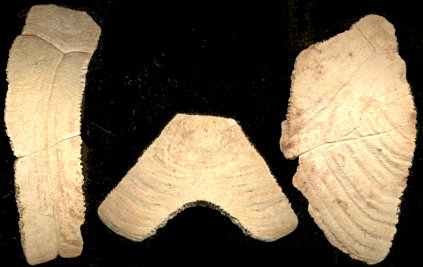
Fig. 1. Carapace elements (5-245) from the Sabertooth Camel Maze, Dry Cave. UTEP specimens.
Moodie and Van Devender (1979) speculated that presence of this taxon implies an absence of prolonged hard frosts.
Sites.
Early/Early-Mid Wisconsin: Sabertooth Camel Maze (Van Devender et al. 1976).
Late Wisconsin: Blackwater Draw Fauna (Brown Sand Wedge) (Slaughter 1975: cf.).
Literature. Johnson 1987; Moodie and Van Devender 1979; Slaughter 1975; Van Devender et al. 1976.
Last Update: 1 Feb 2016